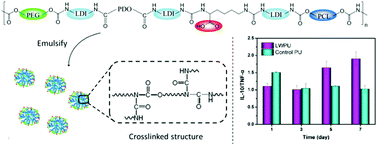Synthesis and characterization of biodegradable lysine-based waterborne polyurethane for soft tissue engineering applications†
Abstract
Biomaterials for soft tissue engineering scaffolds require a combination of multiple properties including suitable mechanical properties, biodegradability, and biocompatibility. In this work, a series of light-crosslinking waterborne polyurethanes (LWPUs) were prepared using L-lysine ethyl ester diisocyanate (LDI), 1,3-propanediol (PDO) and L-lysine as hard segments and poly(ε-caprolactone) (PCL) and poly(ethylene glycol) (PEG) as soft segments. The obtained LWPUs exhibited appropriate stretchability with a break elongation of 1400–2500% and an excellent strength of 12–18 MPa, which could admirably meet the requirements for soft tissue engineering scaffolds. In addition, the hydrophilic surfaces of LWPUs could effectively reduce protein adsorption and platelet adhesion and favor cell proliferation compared with traditional biomedical polyurethanes. The ultimate degradation products of LWPUs were proven to be nontoxic in a cytotoxicity test. More interestingly, a cytokine release test of macrophages adherent to the LWPU film surfaces shows that these macrophages secreted less pro-inflammation cytokine TNF-α and more anti-inflammation cytokine IL-10 after 3 days’ culture, indicating that LWPUs possess the potential ability to aid in the transition of macrophages toward a wound healing phenotype. Furthermore, the LWPU films could support the adhesion and proliferation of endothelial cells. Thus, the obtained LWPUs have great potential for applications in soft tissue engineering scaffolds for tissue repair and wound healing.


 Please wait while we load your content...
Please wait while we load your content...